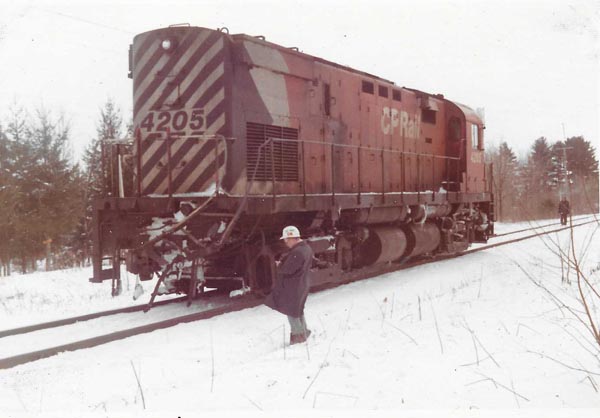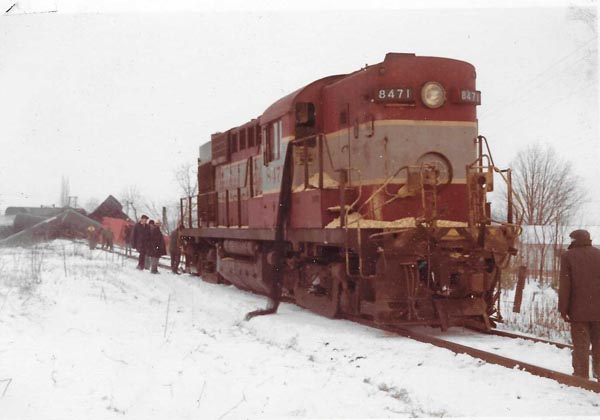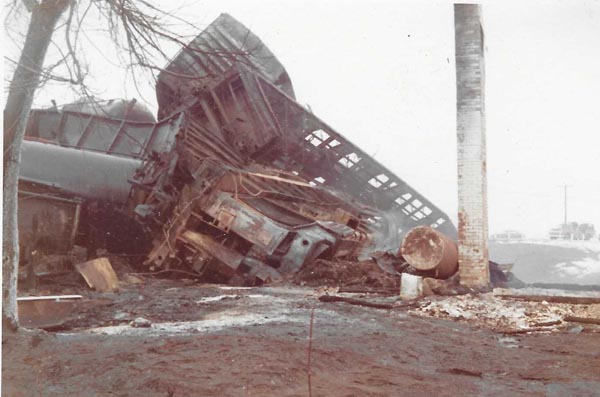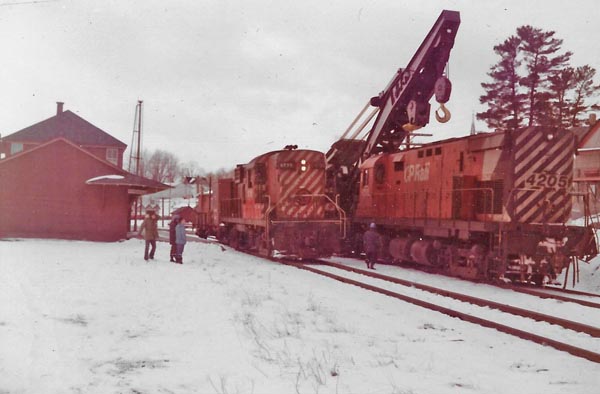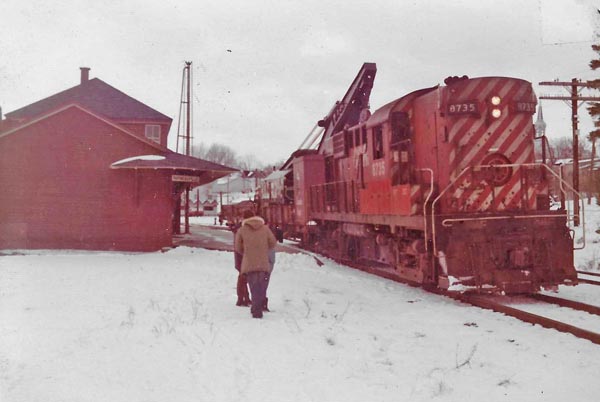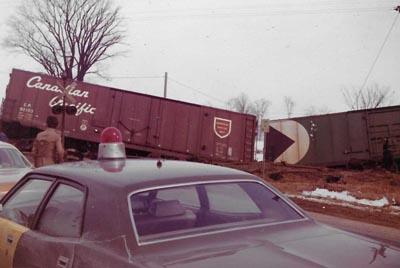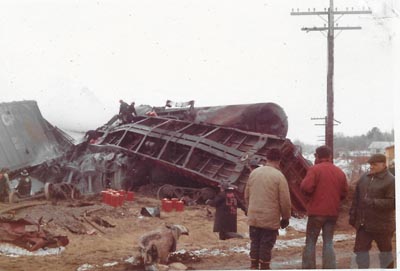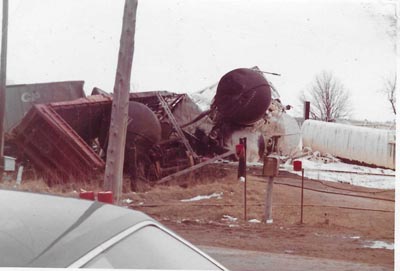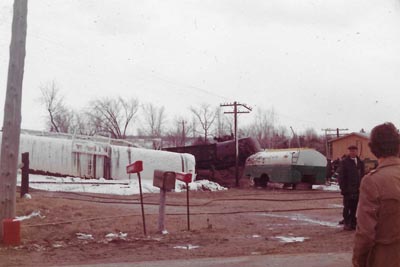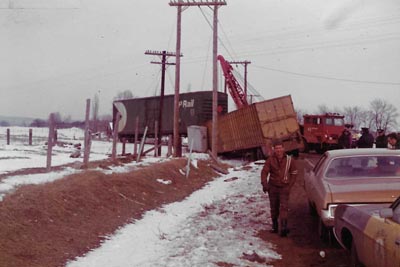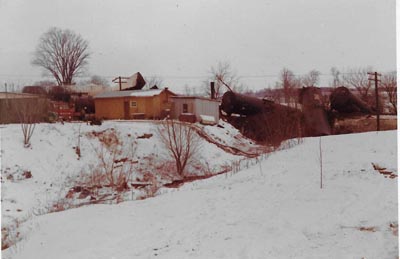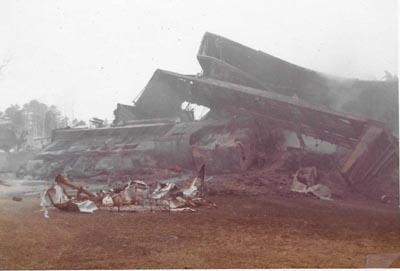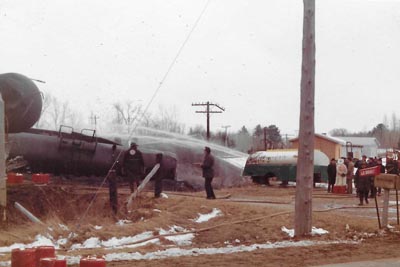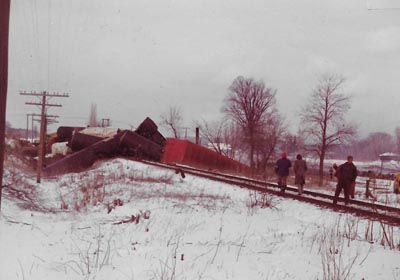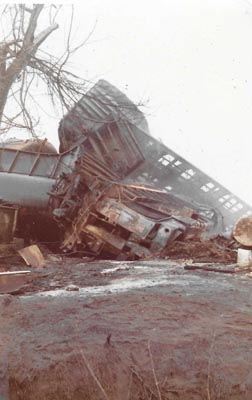Details of Railway Accidents in the Ottawa Area

1973, April 11 - CP through freight from Montreal to Ottawa, #85, was hit by a truck at the east end of Papineauville, Quebec

| Ottawa Citizen 11 April 1973 Train, transport truck collide Several fuel tanker cars were ablaze late this morning after a westbound CP Rail freight train smashed into a transport truck at a crossing between Papineauville and Montebello, about 30 miles east of Hull. Railway officials said they had little information on the derailment, and they did not know whether there had been injuries or deaths. The tanker cars were immediately behind the engines of the freight train and apparently caught fire when they jumped off the tracks after the collision. Ottawa Journal April 12, 1973 'Brakes failed' driver PAPINEAUVILLE (Staff) Brake failure. That's the reason given by the 17-year-old driver of a tractor-trailer who leaped from the cab just before it smashed into the third engine of a 54-car freight train on a Highway .8 crossing just east of here. While the front end of the truck disintegrated on impact, hurling the engine more than 100 feet down the tracks, driver Leo Boutet of St. Basil, near Montreal, escaped injury. Sgt. Andre Leduc of the Papineauville QPF detachment, said the young driver told him that he saw the train coining but that when he tried to stop, he found that he had no brakes. He barely had time to jump from the cab of the truck before it crashed into the heavy engine. The crash knocked one of the three engines pulling the train off the track, into the nearby home of Normand Allard. More than a dozen cars, including including nine oil-tanker cars and a car loaded with liquified chlorine, were burled about like a child's toys. Three of the 17,000 gallon tankers ruptured, sending their flaming contents spewing over the surrounding area, including the home of Mr. Allard, which was destroyed in the blaze. About two acres of land immediately east of the crash site was turned into a blackened desert as the burning oil spread. More than 80 firemen from departments in Gatineau, Thurso, Buckingham,. Montebello, St Andrelinand Papineauville converged on the scene. Their major concern was that Irhe tanker loaded with 20,000 .gallons of chlorine might rupture and spread deadly gas throughout the area. Pumping water from a nearby creek, the firemen worked feverishly for more than four hours, pouring water on the chlorine tanker to keep its temperature below the point where the gas would have expanded and burst the safety valve on the car. Other firemen fought the blaze that ripped through the tangled wreckage. It was brought under control shortly after 1 p.m. Police had evacuated more than 100 families living within a one mile radius of the crash scene. "The tanker is specially de signed to withstand the stress of a derailment," said an official of Standard Chemical Ltd., the owner. "There wasn't even a rivet blown on the thing," he said. Ross Maitland, Canadian Transport Commission chemical engineer on the site to advise in the handling of the dangerous gas, said "the liquified chlorine turns to yellowish green colored fumes when exposed to air. It mixes readily with water and forms hydrochloric acid," he said. "If breathed into the lungs, death is almost instantaneous," he said. The only injuries were to the trainman in the second engine, Claude Baril; who suffered a broken wrist and train engineer Claude Beris, who suffered cuts to his face and one arm. Shortly after 2 p.m., police began to allow the families to return to their homes. But it was after 4 p.m. before Highway 8 was reopened to traffic. A Standard Chemical official said a tanker truck would probably be brought to the scene to pump the 55 tons of chlorine out of the tanker which lay on its side under a pile of oil tankers. Several thousand gallons of oil flowed into a creek near the scene and emptied into the Ottawa River, about half a mile away but officials from the Quebec department of the environment were on the scene early in the afternoon to place a barrier m the creek to catch the oil. A neutralizer was sprayed on the oil. A spokesman for CP Rail said it was expected the wreckage would not be cleared until noon today after which time extensive repairs to the damaged rail ties would have to be carried out. Passengers travelling CP Rail between Ottawa and Montreal last night and this morning were bused between Ottawa and Montebello and travelled by day liner on the Montebello to Montreal section. The final irony of the crash. An oil tanker truck travelling on the detour around the crash scene overturned on the St. Hyacinthe Range, and temporarily blocked the detour Wednesday afternoon. The driver was not injured. Ottawa Citizen 12 April 1973 Tanker car in collision Deadly cargo saved By Scott Honeyman and Tom Van Dusen Citizen staff writers PAPINEAUVILLE A tanker car full of chlorine sat in the middle of an oil-fuelled inferno after a derailment here Wednesday, but firemen kept its deadly cargo from escaping. The end of the car painted red to indicate dangerous cargo could be seen through sheets of flame that soared from six fuel cars after the westbound CP Rail freight train was hit by a semi-trailer truck. More than 100 firemen from every town between Gatineau and Grenville a stretch of about 60 miles poured water onto the damaged chlorine car, and had to ignore flames that levelled a house, shed and travel trailer. Canadian Transport Commission chemical engineer Ross Maitland said he was surprised the intense heat from blazing Bunker C oil and gasoline didn't cause pressure valves on the chlorine car to rupture. Had the valves gone, great clouds of green chlorine gas would have escaped as the chlorine was converted from pressure-packed liquid to poisonous gas, choking anyone in its path. Residents evacuated Mr. Maitland said it was fortunate the wind was blowing from the north west, away from Papineauville and across the Ottawa River to an uninhabited area. Playing it safely, Quebec Provincial Police ordered a square-mile area surrounding the wreck evacuated, sending about 300 residents west to Papineauville. While most of the battle was to stop the chlorine tanker from leaking, thousands of gallons of heavy, tar-like oil spilled from ruptured oil tankers into a creek which flows directly into the Ottawa River. The slick it created In the river could be seen from more than a mile away Ottawa Citizen 13 April 1973 Weeks of Study May Find Cause By David Smithers Citizen staff writer PAPINEAUVILLE Trains again rumbled through this community Thursday night, but the task of investigating the cause of Wednesday's massive derailment will take weeks. In addition, environment experts are still cleaning up the mess left after thousands of gallons of bunker oil spewed from ruptured tanker cars into the Ottawa River. CP Rail crews have worked around the clock since the derailment which occurred about 10 a.m. Wedensday clearing the main line. A truck slammed into the locomotive leading the 100-car train. Twenty cars, some carrying the bunker oil, one carrying chlorine, and another a caustic substance, ripped up the track. Wrong licence Flaming oil razed a nearby house, travel trailer and a shed. There were no serious injuries. The driver of the heavy truck, Leo Boutet, 17, of St. Basil, Que., leaped from the vehicle seconds before the collision. He told police the brakes failed. Police said today the teenager was improperly licensed to drive the truck. He had an operator's license but needed a chauffeur's permit, said QPP Sgt. Andre Leduc today. Mechanics from provincial transport department headquarters were at the scene today examining what was left of the vehicle. Welfare officials are still attempting to find accommodation for the family of 10 whose home was destroyed by the fire. The Normand Allards fled for their lives after their house was drenched in flaming oil. They are staying with relatives in nearby Plaisance. The federal department of the environment assumed responsibility Thursday for cleaning up what was left of the oil spill. Little was done to contain the treacly oil for about 24 hours after the accident. Thousands of gallons poured into a creek which flows 500 feet to the Ottawa.. Booms are In place today to ensure remaining oil is contained. Officials of the Canadian Wildlife Service were also touring the downstream waterfront Thursday, checking for possible damage the oil may have caused migrating geese and ducks. There have been no reports of injury to wildlife, but checks continue. In addition, Ontario environment inspectors are checking the southern shore of the Ottawa for possible oil contamination. Ottawa Citizen 11 May 1973 CP SUING SMALL FIRM OVER CRASH CP Rail is suing a small Quebec trucking company for $1 million as the result of last month's train-truck collision at Papineauville. The suit has been filed in Hull Superior Court against La Compagnie Geralain, whose semitrailer truck was in collision with the side of a freight. Nineteen cars were derailed. The derailment caused extensive fire damage and oil pollution. One home was destroyed when tank cars caught fire. CP Rail alleges in its suit that the brakes failed on the truck, which was being driven by a 17-year-old, who managed to throw himself clear just before the collision. The railway company says it cleaned up the oil spillage, although it denies responsibility. Fuel spilled into a stream which flows into the Ottawa River. Ottawa Citizen 29 September 1976 Lawsuits from '73 train-truck collision heard in Hull Court Hearings into lawsuits involving damage claims of more than $I million resulting from a Papineauville train-truck collision three years ago started in Hull court today. In one suit CP Rail is claiming $I million from a local trucking company. In the other, a Papineauville family is claiming damages of $167,800 from CP Rail and the same trucking firm, Geralin Inc. In the second suit, the Quebec Solicitor-General's Department is also named. Mr. and Mrs. George Lalande's house was destroyed on the morning of April 11, 1973, after a truck owned by Geralin struck a 100-car freight train at a level crossing, resulting in a 20-car derailment. One of the train's three engines also jumped the tracks. Bunker C oil from the derailed tanker cars spewed out ablaze and set fire to the nearby two-storey house where the Lalandes lived with their daughter, her husband, and nine grandchildren. Although four members of the family were home at the time, none were seriously injured. The blazing inferno, fought for several hours by 100 firemen, also forced the evacuation of 300 nearby residents because one of the tanker cars contained highly toxic chlorine.Truck driver Leo Boutet of St. Basil, Que., 17 at the time, jumped clear of his truck moments before it smashed into one of the locomotives. He told police his brakes failed as he approached the level crossing. From Ottawa Citizen 29 September 1976 Law suits from '73 train-truck collision heard in Hull court Hearings into lawsuits involving damage claims of more than SI million resulting from a Papineauville train-truck collision three years ago started in Hull court today. In one suit CP Rail is claiming $I million from a local trucking company. In the other, a Papineauville family is claiming damages of $167,800 from CP Rail and the same trucking firm, Geralin Inc. In the second suit, the Quebec Solicitor-General's Department is also named. Mr. and Mrs. George Lalande's house was destroyed on the morning of April 11, 1973, after a truck owned by Geralin struck a 100-car freight train at a level crossing, resulting in a 20-car derailment. One of the train's three engines also jumped the tracks. Bunker C oil from the derailed tanker cars spewed out ablaze and set fire to the nearby two-storey house where the Lalandes lived with their daughter, her husband, and nine grandchildren. Although four members of the family were home at the time, none were seriously injured. The blazing inferno, fought for several hours by 100 firemen, also forced the evacuation of 300 nearby residents because one of the tanker cars contained highly toxic chlorine.Truck driver Leo Boutet of St. Basil, Que., 17 at the time, jumped clear of his truck moments before it smashed into one of the locomotives. He told police his brakes failed as he approached the level crossing. Ottawa Citizen 30 Setember 1976 Truck's brakes faulty prior to crash An hour after a teenager was warned about the condition of a truck he wai driving it crashed into a CP freight train at a level crossing on Highway 418 near Papineauville, Hull court was told Wednesday. The court heard that the warning was given by Thurso garage owner Roma Rossignol who was in the court on the first day of hearings into law suits involving damage claims of more than $I million resulting from the train-truck collision on April 11. 1973. Mr. Rossignol said the driver of the truck, Leo Boutet, told him he was in too much of a hurry to bring the truck in for more extensive repair work during a service call between 8:30 and 9:30 a m. the day of the crash. He said he discovered the brakes were frozen during the call but managed to free them beside the road. He urged Mr. Boutet to at least stop at a place on the way out of Thurso where more antifreeze could be put into the braking system. QPF Corporal Robert Claude said Mr. Boutet, who was 17, did not have a permit to drive a tractor-trailer. Witnesses estimated the truck, which was carrying a full load of woodchips, was going at about 35 miles per hour as it approached the crossing at Papineauville, which is 40 miles east of Hull. The collision - which Mr. Boutet survived - sent one of the train's three engines plowing into the home of Mr. and Mrs. George Lalonde who lived with their daughter, her husband and their nine children. Although four members of the family were home at the time, none was seriously injured. However, the two-storey house caught fire and was destroyed. A large part of the bunker oil which spilled from 20 derailed cars was also destroyed. One of the overturned cars contained highly-toxic chlorine, forcing the evacuation of 300 nearby residents. From Ottawa Citizen 1 October 1976 Runaway Steel Trapper tells court how crash wrecked house By Mark Van Dusen Citizen staff writer Life was crowded but happy in the little house below the railway tracks until the day that tons of runaway steel exploded into the picture. That day was described in court at Hull Thursday by one of the people who lived in the house near Papineauville, 68-year-old George Lalande, a trapper. Mr. Lalande was testifying at the second day of a hearing of lawsuits involving damages of $167,00 from CP Rail, a trucking firm, a truck driver and the Quebec Solicitor-General's Department. The suits result from a train-truck crash on April II, 1973.' CP Rail revised its claim Thursday against the trucking firm, Geralin Inc., of Portneuf, to half a million dollars from its original estimate of SI. 2 million. The collision happened at 10:30 a.m. at a level crossing one mile east of Papineauville on Highway 148. Involved were a tractor trailer owned by Geralin, and a 54-car CP Rail freight train bound for Ottawa from Montreal. On the first day of the hearing, the court heard that the driver of the tractor trailer, Leo Boutet, 17, was not licensed to drive the vehicle which was laden with wood chips. The court was also told he had been warned against driving the truck when the brakes froze only an hour earlier. In the collision, the second of the train's three engines burst into flames and was sent churning from the railroad bed above the two-storey frame house where George Lalande was sleeping. Although 14 people lived in the house Mr. and Mrs. Lalande, a daughter-in-law, their daughter, her husband and their nine children only five were home. Most of the children had only recently left for school. The diesel dug a trench in the land as it hurtled toward the house, and the third engine nose-dived, derailing 20 cars. Blazing oil from overturned tankers washed against the house, setting it on fire. T A car containing highly-toxic chlorine rolled to rest against one wall of the house. More than 300 people were evacuated from the area. The engine came to rest against the house, nudging the outside kitchen wall. Ironically, George Lalande might be dead if it hadn't. Twenty-six years of living near made him immune to the rumble three or four times a day. "The jolt woke me up," he told the hearing. "I only had time to pull on a pair of boots, my pants and an undershirt. The flames were coming in the windows." The others got out ahead of him. The house and four outbuildings were destroyed. There was no insurance. Mr. Lalande, who needed help itemizing his lost trapping, hunting and fishing equipment because he can't read, was the first of the family to appear at the hearing. His life of trapping muskrat 250 pelts and 300 traps were destroyed in the fire along the Ottawa River, prompted a Montreal lawyer to comment, "I didn't know people lived like that any more around here." Diminutive, bent, head cocked for better hearing, Mr. Lalande set off ripples of laughter in the courtroom with his wry answers which were usually accompanied by a wink and a smile. But all were silent when he told how he and his wife, who is over 80, lived in a trailer for five months following the accident, and how they are now renting lodging at a neighbor's for $50 a month. The rest of the family moved to the upstairs of the CP Rail station in Papineauville rent-free. Nobody laughed when Mr. Lalande said CP Rail bulldozers cleaning up after the wreck flattened his strawberry patch. "I don't want any handouts from anybody," he said outside the courtroom. "All I want is enough money to build a house for me and my wife to spend our last days." CP Rail lawyer Albert Gadbois said the company, in revising its claim against Geralin, based the new figure of $507,624 on more detailed accounts not previously tabulated. In earlier testimony, engineer Douglas Chalmers who was driving the train when the truck hit, said he did not know what kind of freight the cars contained. He said he could see the road up to the beginning of a curve but did not see any vehicles as he approached the crossing. Other members of the Lalande family were to itemize their losses today. From Bruce Chapman (including pictures) The collision occurred at at 1030; 3 units were on the train; the third unit, 8565, was buried and caught fire from cars landing on top of it. A house, shed and a trailer were destroyed by flames and thousands of gallons of heavy oil were spilled into a creek which flows directly into the
|

Return to Main Page of Railway Accidents
Updated 21 May 2020
